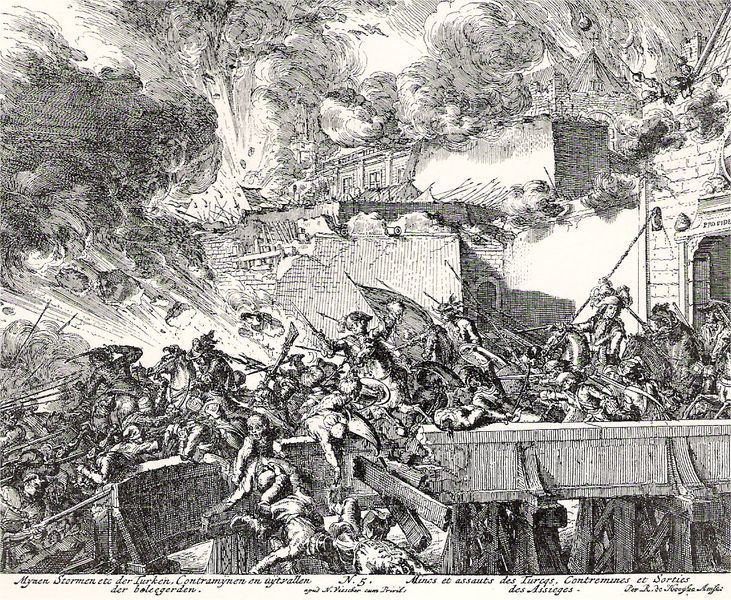 | ||
A breakout is a military operation to end a situation of investment, through offensive operations that achieve a breakthrough. It is used in contexts such as: "The British breakout attempt from Normandy". It is one of four possible outcomes of investment, the others being relief, surrender, or reduction.
Contents
Overview
A breakout is achieved when an invested force launches an attack on the confining enemy forces and achieves a breakthrough, meaning that they successfully occupy positions beyond the original enemy front line and can advance from that position toward an objective or to reunite with friendly forces from which they were separated.
To be categorized a breakout, an invested force is not necessarily required to be completely encircled by an enemy force. Rather, they may have their movement partially restricted by a terrain feature or potentially the use of an area denial weapon such as the VX nerve agent. This was the case in 1944 in the Saint Lo Breakout, where a large portion of the force's movement was restricted by water and not in fact by enemy positions.
While this may be true of a beachhead, it is not necessarily true of a bridgehead. If the bridge is sufficient in capacity compared to the size of the force, and does not significantly restrict their movement, then it does not represent a sufficient barrier for the force to be considered encircled. Similarly, open water may not be a barrier in the same right.
Consider a small detachment of marines with more than sufficient amphibious transports and a significant military presence at sea, such as the beginning stages of the Gallipoli Campaign of the First World War. Had they evacuated to sea, they would retain a significant military presence, as they were principally a naval military force. Conversely, consider the military evacuation of British troops at Dunkirk during the Second World War. This force clearly was pressed by the enemy, and when it broke out (for that's what they did) they lost their effective strength as a fighting force. They were, at the base of it, a land force escaping, and not an amphibious force maneuvering.
The key feature here is the loss of freedom of maneuver. If a force can easily overcome a terrain feature, while maintaining its fighting strength, then it is not breaking out; it is maneuvering in the same way any force would over non-restrictive terrain.
A breakout attempt need not result in a breakthrough, such as the 4th Panzer Army suffered during Operation Winter Storm or the British 1st Armored Division suffered at Campoleone. This is referred to as a failed breakout. A breakout may be attempted in conjunction with relief, and this may be essential especially if the invested force has already experienced failed breakout attempts, (again, as in Winter Storm).
First World War
As the situation on the Western Front during the First World War has been widely regarded as a single continent-long siege, rather than a series of distinct battles, it is possible to consider offensive action from the Allies as a type of breakout. In this sense the Allied armies may be considered encircled, albeit on a hitherto unheard of scale, with the German army to their east, the Alps and the Pyrenees to their south, and the sea to their west and north. Indeed, as the Dunkirk evacuation illustrated, despite having by far the largest navy in the world, the amphibious movements of these armies was nearly impossible logistically. Similarly, as seen at the Battle of Sarikamish, mountaneous terrain remained a significant obstical to military movement and could inflict numerous casualties.
Strategy and tactics
Breakout maneuvers, despite their own myriad risks, may become necessary by a number of disadvantages encircled forces suffer.
The invested force suffers from the disadvantages resulting from occupying a confined space and also from those resulting from a lack of resupply. Therefore, the encircling force has a significant tactical advantage and also have the advantage of time. It may, in fact, choose to not engage their enemy at all and simply wait it out, leading to eventual exhaustion of ammunition if the invested force gives battle or to the eventual exhaustion of food and water otherwise.
The US Army lists four conditions, one of which normally exists when a force attempts a breakout maneuver:
Of necessity, the broad concept is subject to interpretation. In The Blitzkrieg Myth, John Mosier questions whether the concept as applied to tank and other warfare in World War II was more misleading to planning than it is helpful, on account of the numerous exceptional conditions faced in war and also whether evaluation based largely on how well breakout or breakthrough potential was realized is appropriate
Examples
An example is the battle of Hube's Pocket on the Eastern Front in World War II, where the German First Panzer Army was encircled by Soviet forces but broke out by attacking west and linking with the II SS Panzer Corps, which was breaking into the encirclement from outside.
